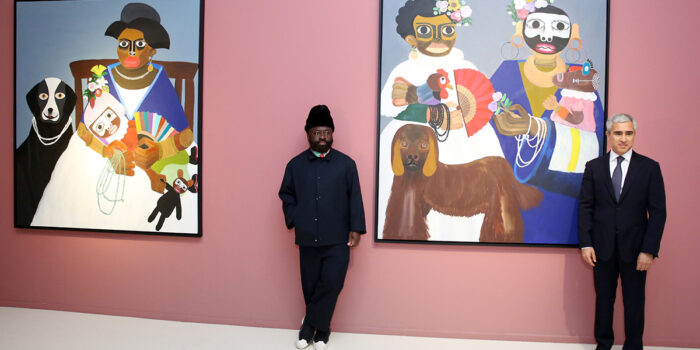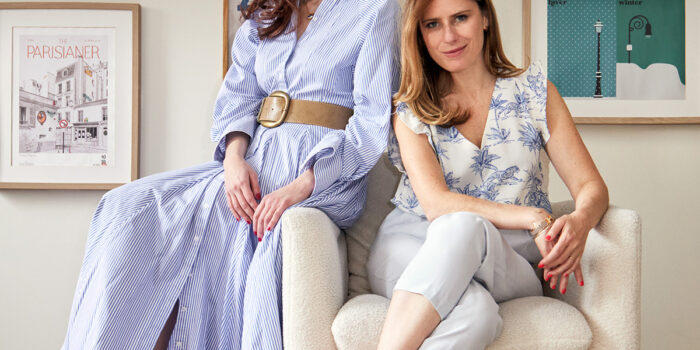Like his paintings, Conrad Jon Godly dominates a room. While gallerists and assistants frantically ready the JD Malat Gallery for its latest exhibition, To See is Not to Speak, a showing of the vast alpine landscapes for which he is most famous, the artist (a cool 6”4, with a shock of white-blond hair) is unflappable, as Benn Sheridan discovers
Perhaps this should not come as a surprise: in his twenties, after five years of art school, Conrad swapped canvas for camera and spent two decades working as a fashion photographer, leading the high octane jetset lifestyle most struggling artists can only dream of. That career happened “almost by accident” he explains, and the choice to switch back to art was an easy one: while working in fashion, he says, “in the back of my mind I knew that I’d never really developed my own style… I was surrounded by people, teams, for so many years – I got fed up”.
When he returned to his hometown, Davos, in Switzerland, after years spent “in the metropolis” – first Berlin, then Tokyo – Conrad began to see things with new eyes, especially the mountains. For him, the urge to paint them was magnetic. “They have a huge influence on me as a human and as a painter.” However, he dislikes the label of landscape painter: “I never try to paint any particular mountain – I am interested in the essence.”
For some, painting the same subject year in and year out might become – how to put it? – boring, but Conrad never tires of the mountains. Painting them, he explains, is “part of my challenge – can I still change something, can I reduce it?” This search for “essence” drives Conrad to create his art at a frenetic pace: when he paints, he does so indoors in his studio, rather than en plein air, and, save for “some photos to remind myself of the light, the details”, he paints from memory. The hardest part is achieving the right level of concentration before he begins. “But”, he smiles, “once I start it’s really fast. I paint without sketching: it’s very physical.” He’s not kidding: Conrad uses brushes up to 70 centimetres wide and uses “mountains” of paint, which he throws and mixes on the canvas.
Conrad sees his paintings as a collaboration between himself and the canvas: “sometimes”, he says (ever fond of the mountainous metaphor), “I have avalanches of paint… sometimes I leave it, sometimes I correct it.” The difficulty, he says, is knowing when to stop. His previous career in fashion has made him wary of a world where “there isn’t anything that’s not manipulated.” Instead, Conrad likes his painting to be “just wild”.
The results are startling. Thick paint is expertly sculpted into peaks and troughs using no more than three basic colours. In fact, he says he could only ever paint in black and white and it would be enough, #17 (main image) acting as a perfect example. This process lends his paintings an eerie, three-dimensional quality that is almost photographic. Conrad’s style sits at the border between realism and abstraction, though he is initially reluctant to label his work as belonging to any one particular school. “My influence is nature itself,” he says. “It’s not something where other artists could influence me.”
Conrad does admire other artists – though perhaps not those one might expect, namely the Old Masters and JW Turner in particular. Once drawn, he finds the comparison hard to shake. “Maybe we have similar souls, but when I look at the works of Turner, even though we could have been a totally different kind of man as a private person, as a painter, he touches me.”
Conrad hums with an energy which suggests he will soon be back in the studio. “I want to do more with less. It’s going to be more wild, more reduced.” And what is his favourite work from the new series? He leads the way towards #23, a green-brown landscape which is a far cry from the crisp blue pistes that surround it in the gallery space. “This”, he says, “is the beginning of something new.” It is the last painting he completed for To See is Not to Speak, and, he explains, as so often happens when he has finished a series, the last painting opens up something new. He leads me to the far side of the gallery. Those new, muted colours, that inky quality of dissolving edges, one cannot help but see a certain resemblance… “Yes, without thinking, just by doing, it becomes – if you look at it from a distance – very much like Turner…” He’s right, of course.
To See is Not to Speak is on view at JD Malat Gallery until 2 March, 2019
Images courtesy of the artist






